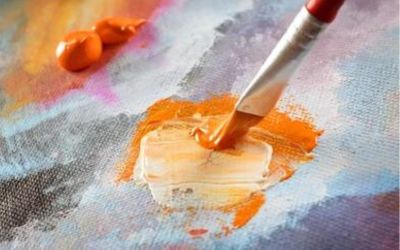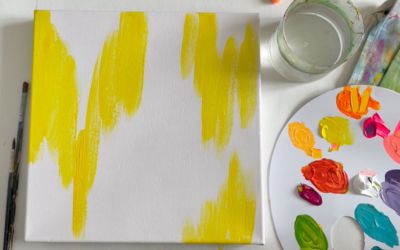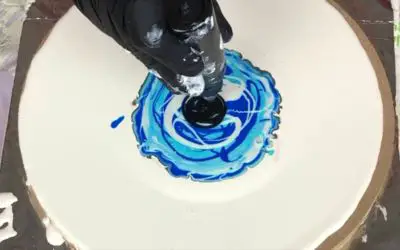Did you know that over 60% of artists struggle with achieving the right transparency in their acrylic paintings?
As a seasoned painter with a decade of experience working with acrylics, I’ve delved deep into mastering the art of transparency.
If you’ve ever grappled with achieving that ethereal, see-through quality in your artwork, this article is crafted for you.
We’ll dive into actionable techniques and solutions on;
- How to Make Acrylic Paint Transparent on various surfaces
- The Nature of Acrylic Paint
- Advanced Technical Techniques for Transparency
- Common Mistakes and How to Avoid Them
- Caring for Transparent Acrylic Artworks
How to Make Acrylic Paint Transparent
To make acrylic paint transparent, you have a few options. Apply thin layers, use 50-60% water for transparency, or add 40% of pouring, glazing, iridescent, gels, or acrylic mediums. Liquitex Glazing Fluid also works great to make acrylic paint transparent. You can also use glazing fluid to mix with your paint.
13 Ways to Make Acrylic Paints Transparent
Making acrylic paint transparent is no longer an uphill task. Here are the 13 easy ways to make your acrylic paints transparent:
1. Apply thin layers
By adding thin layers, gradually increase the transparency of the paint until you achieve the desired effect.
This method also gives you more control over the final result and can prevent the paint from becoming too transparent quickly.
Wait for each layer to dry completely before applying the next layer to avoid overworking the paint and causing it to become muddy.
2. Use transparent Matte Acrylic Medium
Adding a transparent matte medium to acrylic paint effectively increases its transparency while maintaining a matte finish.
This is useful to achieve a transparent effect without adding a glossy finish. A transparent matte medium can also help extend the paint’s drying time.
This makes it easier to blend and work with. To do this, mix a small amount of the transparent matte medium with acrylic paint and then apply it to the painting surface.
3. Add airbrush medium instead of water
Another way to make acrylic paint transparent is by adding an airbrush medium instead of water.
This helps in increasing its transparency without sacrificing its viscosity and adhesion.
The Airbrush medium is designed to thin the paint without affecting its binding properties.
Use this to achieve a transparent effect while maintaining control over the paint’s consistency.
This method can also prevent acrylic paint from becoming too watery and losing its vibrancy.
The best ratio of airbrush medium to paint is usually one part medium to two parts paint.
4. Use Golden Acrylic Retarder
Mixing golden acrylic retarders with acrylic paint is an effective way to slow down the drying time of the paint.
It also blends and increases its transparency. If you want transparency while working with a slower-drying paint, this is your go-to medium.
Golden Acrylic glazing liquid is also designed to extend the working time of the paint, which can help prevent it from becoming too dry and difficult to work with.
Another advantage is that it won’t change the feel of the paint. Mix one to two parts acrylic retarder with four parts paint to use it.
This ratio can be adjusted according to your desire for increased transparency. Remember, using too much retarder will separate the paint and create a milky effect on your painting.
5. Use Gloss Acrylic Medium for a lighter and glossy finish
What I love about gloss acrylic medium is that it not only gives you a lighter and glossy finish but also helps prevent the paint from cracking.
It can be used in various ways to make your paint more transparent. To use this product, all you need to do is mix it with your acrylic paint before applying it to your surface.
This will help thin out the paint and create a transparent look. You may need to experiment with different amounts of medium and paint until you get the desired effect.
This is also an inexpensive way to achieve a semi-transparent coat that still shows some texture.
A gloss medium will also help to extend the drying time of the paint, which can make it easier to work with and prevent the paint from becoming too dry.
You can use this medium on many surfaces, such as canvas, wood, and fabric.
6. Use Acrylic Gel Medium
Did you know you can also use acrylic gel medium to make your paint more transparent?
This is a great option if you’re looking for an even more sheer finish than what you get with the gloss medium.
Acrylic gel medium is a good choice when you want to achieve a softer and more diffused look or if you’re trying to enhance the texture of your artwork.
To use this product, mix it with your acrylic paint before applying it to the surface. Experiment with different amounts until you achieve the desired effect.
7. Use transparent colors for easy transparency
Choosing transparent colors when mixing acrylic paint can be an easy way to achieve transparency without adding additional mediums or additives.
Transparent colors are designed to be more translucent and easier to work with when trying to achieve a transparent effect.
When choosing colors, choose a light color, which will help create a more transparent look.
Experiment with mixing different colors until you get the desired effect.
Now, find out whether the ATM acrylic tank manufacturing still operates.
8. Use 50% of water for transparency enhancement
Mixing acrylic paint with 50% water can increase its transparency without significantly altering the color.
When considering the water-to-acrylic paint ratio for pouring, it’s important to remember that excessive water can result in a thin consistency, making the paint challenging to handle.
Start with a small amount of water and add more until you get the desired effect.
Use this method to create layers of transparent paint by adding different amounts of water for each layer you apply.
Try and be creative enough to create unique and interesting effects.
9. Use cheap acrylic paint
For once, a cheap commodity is winning. Cheaper acrylic paint may be less opaque and, therefore, more transparent.
This makes it a good choice for creating a transparent effect. Not only is it less expensive, but it also has a thin and watery consistency that makes it easier to work with.
Remember that the paint’s quality may not be as good, so you may need to apply multiple layers or experiment with different colors until you get the desired effect.
10. Use a pouring medium to make acrylic paint transparent
A pouring medium is a liquid additive that makes acrylic paint smoother and easier to work with.
It contains various ingredients, such as acrylic polymer emulsions and other resins.
Adding a pouring medium to your paint can help thin it, making it less opaque and more transparent.
Experiment with different amounts of the medium until you get the desired effect.
11. Use an Iridescent medium
From the term iridescent, I know you understand what this medium will do to your acrylic paint.
This medium creates a light-reflective, shimmery, and transparent effect on your painting surface.
Mix it with your acrylic paint before applying it to the painting for an amazing end product.
12. Use floetrol
Floetrol is a liquid additive that can make acrylic paint easier to work with. It helps to increase the paint’s transparency by making it smoother and less viscous.
I recommend it because it contains no solvents, making it less likely to damage your painting surface.
If you can’t find one, here are some floetrol substitutes.
13. Use acrylic flow improver
Acrylic flow improver is designed to increase acrylic paint’s flow and workability.
Use it to make acrylic paint more transparent by breaking down the surface tension of the paint and allowing it to spread more easily.
To use an acrylic flow improver to make acrylic paint more transparent, mix the paint and flow improver in a ratio of 10:1.
This means adding 10 parts of paint to 1 part of the flow improver. Adjust the ratio to achieve the desired level of transparency and consistency.
Once the paint and flow improver are mixed, apply the paint to your surface using a brush, palette knife, or other tool.
The paint should have a more fluid consistency than usual, making it easier to apply and manipulate.
Are Acrylic Paints Opaque?
Acrylic paints can be opaque, transparent, or translucent, depending on the paint’s color and formulation.
Some acrylic paints are formulated to be opaque. This means they will completely cover the surface they are applied to and obscure any underlying layers.
Acrylic paints tend to be more opaque than watercolors or gouache but less opaque than oil paints.

However, the opacity of acrylic paints can vary depending on the pigment used and the amount of pigment in the paint.
Some colors are more opaque than others, and some manufacturers offer different opacity levels for the same color.
Interesting Read: Best Gouache for Beginners
How to Make Acrylic Paint Transparent for Glass

Do you love creating beautiful art on glass but find that your acrylic paint isn’t transparent enough? Well, don’t worry because there’s a solution.
By adding a clear acrylic medium to your paint, you can make it transparent and achieve the
stunning results you’re after.
Here’s how:
Choose the type of acrylic medium that you want to use. Do you want a glossy finish or a more subdued matte finish?
Once you’ve decided, mix a small amount of the medium into your paint and stir well.
Start with a small amount of medium and gradually add more until you achieve the desired level of transparency.
To test the transparency of your paint, apply a small amount to a piece of glass and let it dry completely.
If the paint is still not transparent enough, add more medium and test again until you get the desired look.
Now it’s time to apply your transparent paint to your glass canvas. Use a brush or sponge to apply the paint to the glass; be careful not to apply too much pressure.
Allow the paint to dry completely before handling the glass to avoid smudging or smearing.
Finally, seal paint on glass with a clear acrylic sealer to protect your beautiful creation. This will help prevent scratches and damage and ensure your art lasts for years.
How to Make Acrylic Paint Transparent for Plastic
Have you tried working with acrylic on plastic but found it frustrating when trying to achieve a transparent effect? Don’t worry, you’re not alone.
One common question is, ‘Will acrylic paint stick to plastic?’ The good news is that acrylic paint can adhere to plastic surfaces quite well, especially when properly prepared.
Many artists struggle with the paint opacity of acrylic when painting on plastic. Luckily, there are several ways to make it more transparent.
One method is to dilute the paint with water or acrylic medium. Mix in a small amount of water or medium to reduce the paint’s opacity and create a more translucent effect.
Another option is to use a glazing medium to make the paint more transparent without affecting its consistency or drying time.
Applying thin layers of paint instead of thick coats can also help reduce opacity.
Use transparent or translucent colors like phthalo green, phthalo blue, or quinacridone magenta to add depth and complexity to your painting.
Whether you’re a seasoned artist or just starting out, these techniques can help you achieve the perfect transparent effect on plastic surfaces with acrylic paint.
Don’t let the opacity of acrylic paint hold you back. Experiment with these methods to achieve stunning results in your art.
What should you do next? Protect your paint using acrylic paint sealer for plastic.
How to Make Acrylic Paint Transparent on Canvas
Here are some ideas on things to paint on a black canvas before you start.
The inherent opacity of acrylic paint can be frustrating. It is even worse when painting on canvas for the first time.
But fear not. There are ways to make acrylic paint more transparent on canvas.
One method is to dilute the paint with water or an acrylic medium. This will reduce its opacity and create a more translucent effect.
Another option is to use glazing techniques like thin layering and transparent washes of paint over each other to build up depth and luminosity.
This method requires patience and skill but can produce stunning results. Remember that acrylic paint dries quickly, so work fast using these techniques.
You can also try using a palette knife or brush to scrape away layers of paint and create interesting textures and patterns.
Whether you’re a beginner or an experienced artist, experimenting with these techniques can open up a whole new world of possibilities for your acrylic paintings on canvas.
So don’t be afraid to push the boundaries and explore the potential of acrylic paint as a transparent medium on canvas.
You may discover a whole new level of artistic expression with a little practice and experimentation.
Read Also: Can You Tie Dye With Acrylic Paint
How to Make Acrylic Paint Transparent on Paper
To make acrylic paint transparent on paper, you can mix it with a transparent medium or thin it with water.
Apply thin layers of diluted paint to gradually build transparency. Another option is to use transparent acrylic inks or glazes.
Experimenting with different techniques and layering will help achieve the desired transparency.
It’s recommended to practice in an acrylic painting sketchbook to explore various methods and effects on paper before creating final artwork.
Advanced Technical Techniques for Transparency
There are more technical ways of making acrylic paint translucent. Let’s look at some of them:
Thin layering
Thin layering involves applying a very thin layer of acrylic paint to the surface. This allows the acrylic painting’s transparent layers to show through and creates a translucent effect.
By gradually building up the layers, you can achieve greater transparency.
The key to achieving a thin layering technique is to use a light touch with the brush and to allow each layer to dry completely before applying the next.
This technique is effective when painting landscapes or other scenes that require a sense of depth and atmosphere.
However, remember that the colors used will be affected by each layer, so be careful when selecting your colors.
Use thinner brush
Using a thinner brush can also help to create a more transparent effect. A thin brush will deposit less paint onto the surface, allowing the underlying layers to show more clearly.
This is effective when painting details or creating fine lines. It’s also useful for blending and creating subtle gradations of color.
However, the thinner brush will take longer to apply paint, so patience is key.
When applying, use light, even strokes, for the best effect. Do not press too hard, or the paint will become opaque.
Scraping techniques

Scraping techniques involve using a tool such as a credit card or palette knife to scrape away layers of paint.
This can create a textured effect and reveal the layers of paint underneath, creating a sense of depth and transparency.
Use this technique with multiple colors, as it can create a range of interesting textures and patterns.
But first, practice on a scrap piece of paper first, as scraping too deeply can cause the paint to become completely opaque.
Ensure that each layer is completely dry before scraping away. You do not want to mix the colors together accidentally.
Do you know how to make acrylic paint opaque?
Use a palette knife or spatula
Applying a palette knife or spatula to paint can create a more transparent effect.
By applying the paint thinly and manipulating it with the knife, you can create a range of textures and effects that allow the underlying layers to show through.
Do this when creating Impasto effects or adding texture to a painting.
In doing this, make sure you use a light touch and do not press too hard with the knife, as this can cause the paint to become opaque.
Read also: How to make acrylic paint thicker.
How to paint something to look transparent
To paint something to look transparent, start with a light base layer. Apply thin, layered strokes of desired colors, allowing each to dry.
Gradually build intensity using glazing techniques with a transparent medium. Enhance by capturing light reflections and shadows.
Consistent layering and observation of translucency effects are key to achieving the transparent look.
Common Mistakes and How to Avoid Them
Mastering the technique of making acrylic paint transparent is rewarding, but it also comes with its share of pitfalls.
Over-dilution of Paint
One of the most frequent errors artists make is adding excessive water.
While a little dilution can enhance transparency, too much compromises the paint’s integrity, leading to a washed-out appearance and poor adhesion to the canvas.
Using Incompatible Mediums
Not all mediums work harmoniously with every acrylic paint.
Choose mediums that align with your paint type to maintain consistency and vibrancy.
Muddying Colors
Mixing too many hues or layering without adequate drying can result in muddied, unclear colors.
Be patient and allow each layer to dry to preserve the intended transparency and brilliance.
FAQs
What medium makes the acrylic paint more transparent?
The acrylic glazing medium will make the paint more transparent. Acrylic glazing medium comes in glossy and matte finishes, so you can choose the one that best suits your painting project. By adding a glazing medium to acrylics, you can create a thinner, more translucent layer of paint on your painting.
How do you change the transparency of acrylic paint?
To change the transparency of the acrylic paint, mix the paint with white or a transparent medium. Add more water to thin the paint, use an airbrush to spray on the paint, and glaze with varnish or glazing liquid. Mix in a pouring medium to create flow and texture, or layer multiple coats of lighter colors.
How do you make clear acrylic?
Clearing acrylic is a simple process, provided you have the right tools and techniques. The most common method for making transparent acrylic colors involves using a medium such as Liquitex Clear Gesso or Gloss Medium & Varnish to thin out your paints. You can also use water and other mediums to create a transparent layer.
Related Post: Can You Sublimate on Clear Acrylic?
Why is my acrylic paint transparent?
Your acrylic paint has a transparent color because of less pigment and more filler. This can be caused by several things, including incorrect mixing, over-dilution, or lack of a binder. The pigment and filler may vary due to the type of acrylic paint you are using, but all paints require some degree of transparency for easier application and blending.
Can black acrylic paint be transparent?
Yes, you can make black acrylic paint transparent. The best way to do this is to use mediums to thin the paint, such as water, flow improver, and retarder. To make an even more transparent effect, use glazing mediums such as gloss or matte medium. You can also add transparent colors to create unique custom shades of black.
How to make white paint transparent?
You can make your white paint transparent using mediums like Liquitex, Golden Open Acrylics, or floetrol to thin out the paint and make it more transparent. You can also add water or an extender to improve the paint’s flow. Apply layers of the same color lightly so that colors don’t mix together and create an opaque hue.
Is Liquitex acrylic paint transparent?
Yes, Liquitex acrylic paint is transparent. It is water-based, non-toxic, and offers excellent flexibility and adhesion. Liquitex has a wide range of transparent colors in various opacity levels to suit any project. The pigments are lightfast, meaning they won’t fade over time when exposed to sunlight or UV rays.
How to make acrylic paint translucent
To make acrylic paint translucent, mix it with a transparent medium or water. Apply in thin layers, allowing each to dry. Adjust transparency by varying medium-to-paint ratio. Choose transparent acrylic hues for enhanced translucency. Proper layering and medium choice are crucial for achieving the desired translucence in your acrylic paint applicatio
Final thoughts on how to make acrylic paint transparent
Acrylic paint doesn’t have to be frustrating when trying to achieve transparency in your artwork.
With these techniques, you can unlock the full potential of this versatile medium and create stunning, translucent effects on a variety of surfaces.
Whether you’re a beginner or an experienced artist, don’t be afraid to experiment and try new things.
You never know what new techniques or combinations of color might lead to your next masterpiece. So grab your paintbrush and get creative. The possibilities are endless!










Leave a Reply